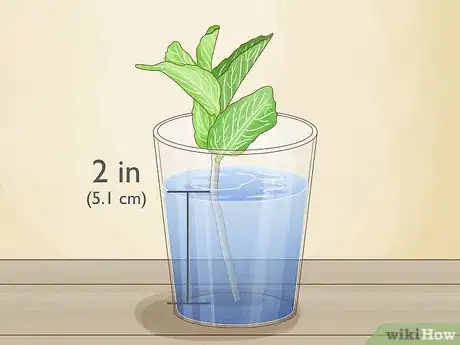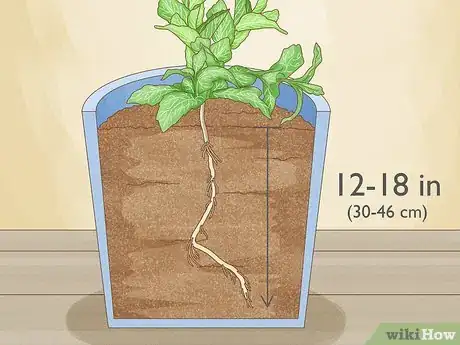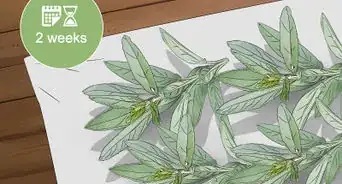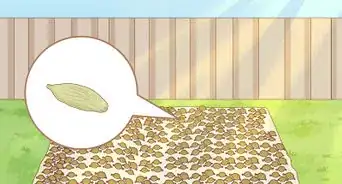This article was co-authored by Harmony Corelitz and by wikiHow staff writer, Jessica Gibson. Harmony Corelitz is a Plant Specialist and the Ecommerce Manager at Crimson Horticultural Rarities, Inc, a boutiue offering rare plants, flower arragements, and handmade goods. Harmony grew up helping her parents run their family business in plant maintenance and interior plantscaping. Harmony specializes in indoor plant care and interior plant design. Prior to her workwith Crimson Horticultural Rarities, she started her pop-up plant and vintage home goods shop called Younger Child and helped her former employer, Plants and Friends, grow and expand to two locations. She holds a BA from the University of San Francisco.
There are 9 references cited in this article, which can be found at the bottom of the page.
This article has been viewed 18,253 times.
You don't need a green thumb to grow a healthy mint plant. Because it grows quickly and is so resilient, it's perfect for a beginner gardener. In fact, you may end up with too much mint since it spreads so easily! To help you get started with your own fresh mint plant, check out our answers to the most common questions about mint propagation.
Steps
How do you root a mint cutting?
-
1Put the cutting into a glass of cool water. Stick the cutting into the water so the bottom 2 inches (5.1 cm) are submerged. The water keeps the cutting from drying out so roots can start growing.[3]
- Use a clear glass so you can easily see when the plant begins to grow roots.
-
2Set the glass in a sunny spot and let the roots grow for 1 to 2 weeks. Place your glass of water in a sunny window and change the water every day so the stem stays healthy. Check your cutting every few days to watch for tiny white roots growing from the bottom.[4]
- Mint really likes temperatures between 55 and 70 °F (13 and 21 °C). Place your cutting in a warm room, patio, or garage so it grows quickly.
-
3Plant your mint cutting in soil so a new plant can grow. When you see small, white roots coming from the base of the stem, you know it's time to plant! Fill a plant pot with peat-free multipurpose compost or potting soil. Then, use your fingers to make a 2 in (5.1 cm) deep hole and put your cutting into it. Fill in the hole with soil and press down gently. Give your plant a drink of water and let it grow![5]
- Don't forget that your mint loves sunshine. Put your plant pot in a sunny spot in your house or set it outside where it will get lots of natural sunlight.
Why is my mint cutting not growing?
-
1It may not grow if the cutting wasn't healthy to begin with. Look at the leaves of the cutting and the original mint plant, if you still have it. If you spot rust- or orange-colored patches, the plant might have mint rust. This is a fungal disease that can easily spread to other plants. If your cutting has mint rust, it won't put on healthy growth.[9]
- The best thing you can do is to start with a new, healthy stem.
-
2The stem might be rotting because the water needs to be changed. It's super important to change the water in the cutting glass every single day. If you don't, the water can turn cloudy as bacteria grow. This bacteria can sicken the mint stem so it starts looking dark or slimy. If this happens, you've got to start with a healthy cutting and a new glass of water.
- You don't need to use fancy water—tap water is fine as long as it's fresh!
Warnings
- Mint can spread quickly in your garden—some gardeners consider it to be invasive! If you don't want the mint taking over your other plants, plant your cutting in a container instead of in a garden bed.[10]⧼thumbs_response⧽
References
- ↑ https://www.gardeningpatch.com/herbs/growing-mint//
- ↑ https://youtu.be/ftls90A6f4Y?t=28
- ↑ https://www.gardenersworld.com/how-to/grow-plants/how-to-grow-mint-from-cuttings/
- ↑ https://youtu.be/dqh3DH_JRKU?t=131
- ↑ https://www.gardenersworld.com/how-to/grow-plants/how-to-grow-mint-from-cuttings/
- ↑ https://www.thekitchn.com/everything-you-need-to-know-about-growing-mint-220865
- ↑ http://celosangeles.ucanr.edu/files/121762.pdf
- ↑ https://youtu.be/W5oCcgGixR0?t=347
- ↑ https://www.gardeningpatch.com/herbs/growing-mint/






































































